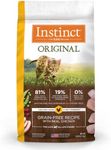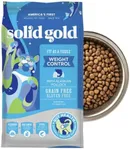Buying Guide for the Best Grain Free Cat Foods
Choosing the right grain-free cat food for your feline friend is crucial for their health and well-being. Grain-free cat foods are designed to mimic a cat's natural diet, which is high in protein and low in carbohydrates. When selecting a grain-free cat food, it's important to consider several key specifications to ensure that the food meets your cat's nutritional needs and preferences. Here are the key specs to look for and how to navigate them.Protein ContentProtein is a vital nutrient for cats, as it supports muscle development, energy levels, and overall health. Grain-free cat foods often have higher protein content compared to regular cat foods. Look for foods with a protein content of at least 30%. For active or growing cats, higher protein levels (35-40%) are beneficial. For older or less active cats, a moderate protein level (30-35%) is sufficient. Choose a protein source that your cat enjoys and can digest well, such as chicken, fish, or turkey.
Carbohydrate LevelsCats are obligate carnivores, meaning they require very few carbohydrates in their diet. Grain-free cat foods typically have lower carbohydrate levels, which is better for your cat's digestion and overall health. Aim for foods with less than 20% carbohydrates. For cats with weight issues or diabetes, even lower carbohydrate levels (below 10%) are ideal. Check the ingredient list for fillers like potatoes or peas, which can increase carbohydrate content.
Fat ContentFat is an essential energy source for cats and helps with the absorption of fat-soluble vitamins. Grain-free cat foods should have a balanced fat content, usually between 15-20%. For active or underweight cats, higher fat content (up to 25%) can provide extra energy. For overweight or less active cats, a lower fat content (10-15%) is preferable. Ensure the fat sources are healthy, such as fish oil or chicken fat.
Ingredients QualityThe quality of ingredients in grain-free cat food is crucial for your cat's health. Look for foods with high-quality, named animal proteins (e.g., chicken, salmon) as the first ingredient. Avoid foods with vague terms like 'meat by-products' or 'animal fat.' High-quality ingredients ensure better nutrition and digestibility. If your cat has allergies or sensitivities, choose foods with limited ingredients or novel protein sources like duck or venison.
Taurine ContentTaurine is an essential amino acid for cats, necessary for heart health, vision, and reproduction. Grain-free cat foods should contain adequate levels of taurine, usually around 0.1-0.2%. Ensure the food you choose lists taurine in the ingredient list. Cats cannot produce enough taurine on their own, so it's important that their diet provides this nutrient.
Moisture ContentMoisture content is important for your cat's hydration, especially if they don't drink much water. Wet grain-free cat foods have higher moisture content (around 75-80%), which can help keep your cat hydrated. Dry grain-free cat foods have lower moisture content (around 10%), so ensure your cat has access to fresh water at all times. If your cat prefers dry food, consider supplementing with wet food or adding water to their kibble.
Life Stage AppropriatenessCats have different nutritional needs at different life stages. Ensure the grain-free cat food you choose is appropriate for your cat's age. Kitten formulas are higher in protein and fat to support growth, while adult formulas are balanced for maintenance. Senior formulas may have adjusted protein and fat levels to support aging cats. Always check the label to ensure the food matches your cat's life stage.





















